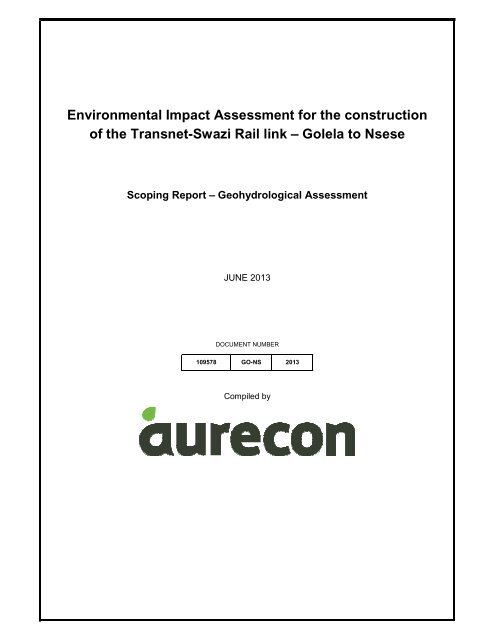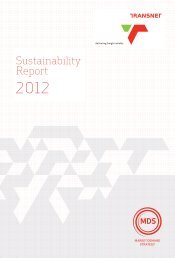Geohydrological - Transnet
Geohydrological - Transnet
Geohydrological - Transnet
- No tags were found...
Create successful ePaper yourself
Turn your PDF publications into a flip-book with our unique Google optimized e-Paper software.
Environmental Impact Assessment for the constructionof the <strong>Transnet</strong>-Swazi Rail link – Golela to NseseScoping Report – <strong>Geohydrological</strong> AssessmentJUNE 2013DOCUMENT NUMBER109578 GO-NS 2013Compiled by
Project Title:Environmental Impact Assessment for the construction of the<strong>Transnet</strong>-Swazi Rail link – Golele to Nsese.Scoping Report – <strong>Geohydrological</strong> AssessmentLocation:Co-ordinates (WGS84):KwaZulu-NatalNAPrepared for:<strong>Transnet</strong> SOC LimitedCarlton Centre150 Commissioner StreetJohannesburg2001Contact person:Mr Khatutshelo TshipalaTel No: 27 11 308 3000Compiled by:Contact Person:AureconLynnwood Bridge Office Park4 Daventry StreetLynwood Manor0081Louis StroebelTel No: 012 427 3151Project team: L Stroebel GeohydrologistM TerblancheGeotechnicianSigned on behalf ofAurecon:L Stroebel
AURECON Doc. No: 109578-GO-NS-2013 Page iiiTABLE OF CONTENTS1 INTRODUCTION ....................................................................................................................................... 12 METHODOLOGY ...................................................................................................................................... 12.1 THE CONSTRUCTION AND OPERATION OF THE RAIL LINK .............................................................................. 12.2 THE UPGRADE OF THE NSESE YARD AT RICHARDS BAY .............................................................................. 22.2.1 Desk study & Site visit ......................................................................................................................... 22.2.2 Hydrocensus & Geophysical survey ................................................................................................... 22.2.3 Drilling ................................................................................................................................................. 22.2.4 Permeability tests and sampling of the newly drilled boreholes ......................................................... 32.2.5 Report .................................................................................................................................................. 3
AURECON Doc. No: 109578-GO-NS-2013 Page 11 INTRODUCTION<strong>Transnet</strong> appointed Aurecon to perform an Environmental Impact Assessment (EIA) for theproposed Swaziland Rail Link project. The project has been broken down into different workpackages and this report will focus on the section stretching from Golela on theSwaziland/KwaZulu-Natal border to Richards Bay. As part of the project, the existing Nsese Yardat Richards Bay will be upgraded which will include amongst other, an increase of the current fuelstorage capacity.As part of the EIA, several specialist studies were required to be included in documentation whichwill form part of the environmental authorisations for the proposed project. A geohydrologicalreport will be required as part of the specialist studies. This document outlines the approach andmethodology of the geohydrological study to describe the baseline conditions in order to quantifypotential impacts, and ultimately develop a groundwater management framework to mitigateidentified potential impacts.The two components of this work package which may have an impact on the geohydrologicalenvironment would be:1. The construction and operation of the rail link itself; and2. The upgrade of the Nsese Yard at Richards Bay.2 METHODOLOGY2.1 The construction and operation of the rail linkThe potential for groundwater contamination is associated with uncontrolled spills of fuels andlubricants during the construction phase, as well as any hazardous material transported during theoperational phase. The extent and impact of potential groundwater contamination is largelydependent on the nature of the subsurface soil, geological & geohydrological conditions.Due to the geographical extent of the rail link, the geohydrological study of this component will belimited to a desk study of available maps, reports and data. Relevant maps of the area wouldinclude:• 1:250 000 Geological Map (2730 Vryheid)• 1:250 000 Geological Map (2732 St. Lucia)• 1:250 000 Geological Map (2830 Richards Bay).• 1:500 000 Hydrogeological Map (2730 Vryheid)• An Explanation of the 1:500 000 General Hydrogeological Map – Vryheid 2730. GM King,April 2003.These maps will be used as base information in the process of delineating aquifers along therailway link. Data from the National Groundwater Database will be used to identify groundwateruse along the route.The product of this desk study will be an aquifer vulnerability map indicating sensitive aquifers andgroundwater users along the route. This map can then be used to quantify potential impactsidentified and associated with the construction and operational phases. This will also includeGolela-Nsese <strong>Geohydrological</strong> Scoping June 2013
AURECON Doc. No: 109578-GO-NS-2013 Page 2possible mitigation measures as part of the EMP to be employed to be able to comply with therelevant environmental legislation.2.2 The upgrade of the Nsese Yard at Richards BayThe potential for groundwater contamination is associated with uncontrolled spills of fuels andlubricants during the construction and operational phases. The extent and impact of potentialgroundwater contamination is largely dependent on the nature of the subsurface soil, geological &geohydrological conditions. During the geohydrological study possible sources will be identifiedand the impact of these sources on the groundwater system as well as its users will be quantified.In order to describe the geohydrological conditions, the following tasks will be conducted.2.2.1 Desk study & Site visitThis phase will consist of a desk study of all available information. Information will be gatheredfrom the following sources:• 1:250 000 Geological Map (2830 Richards Bay).• National Groundwater Database.• Historical relevant reports of groundwater/contamination studies undertaken at the NseseYard.The information listed above will be used to describe aquifers underlying the project area.On completion of the desk study, a site walk-over will be conducted to familiarise ourselves withthe site conditions, its layout and to identify and photograph any visual evidence of potentialcontaminant sources and determine any potential risks associated with the site.2.2.2 Hydrocensus & Geophysical surveyA borehole census will be conducted on the site including an area 1 kilometre from the boundary ofthe project area. The census is necessary to identify legitimate groundwater users and establishthe quality, quantity and usage of groundwater in the vicinity of the site. Water samples will beanalysed for DRO & GRO (diesel and gasoline range organics), as well as the major inorganicelements. Where possible groundwater levels will also be measured and recorded which willassist in the understanding of groundwater flow at the site.Upon completion of the hydrocensus, a geophysical ground survey utilising a combination oftechniques such as electromagnetics, magnetics or resistivity will be conducted to locate anygeological structures such as dykes or faults which may act as preferential flow paths. Based onthe geophysical data the localities for up- and downstream monitoring boreholes will be selected.2.2.3 DrillingDrilling of boreholes is required to investigate the occurrence and quality of groundwater in thearea. Typically one up- and two downstream boreholes of 30m deep will be drilled. Boreholes willbe delivered with UPVC casing, gravel pack, a bentonite seal along with a concrete plinth andlockable cap. Drilling supervision will include appointing a drilling contractor and ensuring thatdrilling is executed to the relevant specifications. Recording of the lithologies and water strikesintersected in each borehole is undertaken during drilling supervision by a qualifiedgeotechnician/geohydrologist.Golela-Nsese <strong>Geohydrological</strong> Scoping June 2013
AURECON Doc. No: 109578-GO-NS-2013 Page 32.2.4 Permeability tests and sampling of the newly drilled boreholesNewly drilled boreholes will be given a ~1 week period to settle and to allow for water levels toreturn to their static levels. Thereafter a falling head test to determine the hydraulic conductivity ofthe geological formations underlying the site will be done. Sampling of the water for chemicalanalysis will be done on completion of the falling head tests.2.2.5 ReportThe product of this investigation will be a report, constructed in such a way that it can easily beincorporated into the final EIA document.The report will discuss the results of the hydrocensus, geophysics, environmental drilling andaquifer testing. The outcome of the geohydrological investigation will be discussed along with theidentified impacts and possible mitigation measures to be employed to be able to comply with therelevant environmental legislation. Conclusions and recommendations regarding monitoringprograms and EMP’s to mitigate potential impacts will be discussed during the reporting phase.Golela-Nsese <strong>Geohydrological</strong> Scoping June 2013
















